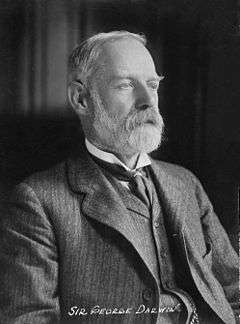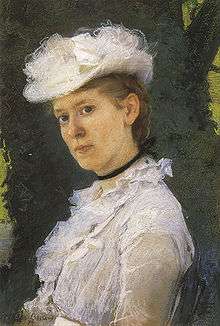George Darwin
Sir George Howard Darwin, KCB FRS FRSE (9 July 1845 – 7 December 1912)[1] was an English barrister and astronomer, the second son and fifth child of Charles Darwin and Emma Darwin.
George Darwin KCB FRS FRSE | |
|---|---|
 Sir George Howard Darwin | |
| Born | George Howard Darwin 9 July 1845 Down House, Downe, Kent, England |
| Died | 7 December 1912 (aged 67) Cambridge, England |
| Nationality | British |
| Alma mater | St John's College, Cambridge Trinity College, Cambridge |
| Awards | Smith's Prize (1868) Royal Medal (1884) Gold Medal of the Royal Astronomical Society (1892) Copley Medal (1911) |
| Scientific career | |
| Fields | Astronomy and mathematics |
| Academic advisors | Edward John Routh |
| Notable students | Ernest William Brown E. T. Whittaker |
| Signature | |
Biography
George H. Darwin was born at Down House, Kent, the fifth child of biologist Charles Darwin and Emma Darwin.
From the age of 11 he studied under Charles Pritchard at Clapham Grammar School, and entered St John's College, Cambridge, in 1863, though he soon moved to Trinity College,[2] where his tutor was Edward John Routh. He graduated as second wrangler in 1868, when he was also placed second for the Smith's Prize and was appointed to a college fellowship. He earned his M.A. in 1871.[2] He was admitted to the bar in 1872, but returned to science.[2] George Darwin conducted studies into the prevalence and health outcomes of contemporary first-cousin marriages in Great Britain. His father Charles had become concerned after the death of three of his children, including his favorite daughter, Annie, from tuberculosis in 1851, that his and Emma's union may have been a mistake from a biological perspective. He was reassured by George's results.[3]
Darwinian mechanics
Although George Darwin was the son of the famous biologist, Charles Darwin, rather than moving predominantly into the field of biology like his father, George instead kept his focus on geology. Subsequently, his efforts within geology caused him to stumble onto many seemingly radical ideas, some of which were related to the notion that preserved within the physical structure of the planet was the mechanical energy (or the collective inertial motion), which may have allowed an ancient rapidly spinning Earth to somehow expelled a piece of its mass, and it was this expelled mass which later congealed to create the natural satellite that was now in orbit around the Earth. So, before the Apollo mission and the rise to prominence of the relativistic notion that the origin of the Moon was due in part to collisions within a very active proto-planetary disk, there was a radically different depiction of lunar and planetary evolution, which was proposed by George Darwin, in 1879, called the Fission Theory.[4][5]
In 1879, he was elected a Fellow of the Royal Society and won their Royal Medal in 1884 and their Copley Medal in 1911.[6] He delivered their Bakerian Lecture in 1891 on the subject of "tidal prediction".
In 1883 Darwin became Plumian Professor of Astronomy and Experimental Philosophy at the University of Cambridge. He studied tidal forces involving the Sun, Moon, and Earth, and formulated the fission theory of Moon formation.[7]
Darwin was a Fellow of the Royal Astronomical Society (RAS) and won the Gold Medal of the RAS in 1892. From 1899–1901 he served as President of the RAS. The RAS founded a prize lectureship in 1984 and named it the George Darwin Lectureship in Darwin's honour.
He was an invited speaker in the International Congress of Mathematicians 1908, Rome on the topic of "Mechanics, Physical Mathematics, Astronomy."[8] As President of the Cambridge Philosophical Society, he also gave the Introductory Address to the Congress in 1912 on the character of pure and applied mathematics.[9]
He received the degree of Doctor mathematicae (honoris causa) from the Royal Frederick University on 6 September 1902, when they celebrated the centennial of the birth of mathematician Niels Henrik Abel.[10][11] Darwin crater on Mars is named after him.[12]
 Sir George Howard Darwin, oil on canvas, Mark Gertler, 1912
Sir George Howard Darwin, oil on canvas, Mark Gertler, 1912 George Darwin ca 1908 by his daughter Gwen Raverat
George Darwin ca 1908 by his daughter Gwen Raverat Lady George Darwin, pastel, Cecilia Beaux, 1889
Lady George Darwin, pastel, Cecilia Beaux, 1889
Family
Darwin married Martha (Maud) du Puy, the daughter of Charles du Puy of Philadelphia, in 1884; his wife was a member of the Ladies Dining Society in Cambridge, with 11 other members.
She died on 6 February 1947. They had three sons and two daughters:
- Gwen Raverat (1885–1957), artist.
- Sir Charles Galton Darwin (1887–1962), physicist and applied mathematician.
- Margaret Elizabeth Darwin (1890–1974), married Sir Geoffrey Keynes.
- William Robert Darwin (1894–1970)
- Leonard Darwin (1899–1899)
George and Maud Darwin bought Newnham Grange, Cambridge in 1885. The Darwins extensively remodelled the house. Since 1962 the Grange has been part of Darwin College, Cambridge.
He is buried in Trumpington Extension Cemetery in Cambridge with his son Leonard and his daughter Gwen (Raverat), his wife Lady Maud Darwin was cremated at Cambridge Crematorium; his brothers Sir Francis Darwin and Sir Horace Darwin and their respective wives are interred in the Parish of the Ascension Burial Ground.
Ancestry
| Ancestors of George Darwin | ||||||||||||||||||||||||||||||||||||||||||||||||||||||||||||||||||||||||||||||||||||||||||||||||||||||||||||||||||||||||||||||||||||||||||||||||||||||||||||||||||||||||||||||||||||||||||||||||||||||||||||||||||||||||||||||||||||||||||||||||||||||||||||||||||||||||||||||||||||||||||||||||||||||||||||||||||||||||||||||||||||||||||||||||||||||||||||||||||||||||||||||||||||||||||||||||||||||||||||||||||||||||||||||||||||||||||||||||||||||||||||||||||||||||||||||||||||||||||||||||||||||||||||||||||||||||||||||||||||||||||||||||||||||||||||||||||||||||||||||||||||||||||||||||||||||||||||||||
|---|---|---|---|---|---|---|---|---|---|---|---|---|---|---|---|---|---|---|---|---|---|---|---|---|---|---|---|---|---|---|---|---|---|---|---|---|---|---|---|---|---|---|---|---|---|---|---|---|---|---|---|---|---|---|---|---|---|---|---|---|---|---|---|---|---|---|---|---|---|---|---|---|---|---|---|---|---|---|---|---|---|---|---|---|---|---|---|---|---|---|---|---|---|---|---|---|---|---|---|---|---|---|---|---|---|---|---|---|---|---|---|---|---|---|---|---|---|---|---|---|---|---|---|---|---|---|---|---|---|---|---|---|---|---|---|---|---|---|---|---|---|---|---|---|---|---|---|---|---|---|---|---|---|---|---|---|---|---|---|---|---|---|---|---|---|---|---|---|---|---|---|---|---|---|---|---|---|---|---|---|---|---|---|---|---|---|---|---|---|---|---|---|---|---|---|---|---|---|---|---|---|---|---|---|---|---|---|---|---|---|---|---|---|---|---|---|---|---|---|---|---|---|---|---|---|---|---|---|---|---|---|---|---|---|---|---|---|---|---|---|---|---|---|---|---|---|---|---|---|---|---|---|---|---|---|---|---|---|---|---|---|---|---|---|---|---|---|---|---|---|---|---|---|---|---|---|---|---|---|---|---|---|---|---|---|---|---|---|---|---|---|---|---|---|---|---|---|---|---|---|---|---|---|---|---|---|---|---|---|---|---|---|---|---|---|---|---|---|---|---|---|---|---|---|---|---|---|---|---|---|---|---|---|---|---|---|---|---|---|---|---|---|---|---|---|---|---|---|---|---|---|---|---|---|---|---|---|---|---|---|---|---|---|---|---|---|---|---|---|---|---|---|---|---|---|---|---|---|---|---|---|---|---|---|---|---|---|---|---|---|---|---|---|---|---|---|---|---|---|---|---|---|---|---|---|---|---|---|---|---|---|---|---|---|---|---|---|---|---|---|---|---|---|---|---|---|---|---|---|---|---|---|---|---|---|---|---|---|---|---|---|---|---|---|---|---|---|---|---|---|---|---|---|---|---|---|---|---|---|---|---|---|---|---|---|---|---|---|---|---|---|---|---|---|---|---|---|---|---|---|---|---|---|---|---|---|---|---|---|---|---|---|---|---|---|---|---|---|---|---|---|---|---|---|---|---|---|---|---|---|---|---|---|---|---|---|---|---|---|---|---|---|---|---|---|---|---|---|---|---|---|---|---|---|---|---|---|---|---|---|---|---|---|---|---|---|---|---|---|---|---|---|---|---|---|---|---|---|---|---|---|---|---|---|---|---|---|---|---|---|---|---|---|---|---|---|---|---|---|---|---|---|---|---|---|---|---|---|---|---|---|---|
| ||||||||||||||||||||||||||||||||||||||||||||||||||||||||||||||||||||||||||||||||||||||||||||||||||||||||||||||||||||||||||||||||||||||||||||||||||||||||||||||||||||||||||||||||||||||||||||||||||||||||||||||||||||||||||||||||||||||||||||||||||||||||||||||||||||||||||||||||||||||||||||||||||||||||||||||||||||||||||||||||||||||||||||||||||||||||||||||||||||||||||||||||||||||||||||||||||||||||||||||||||||||||||||||||||||||||||||||||||||||||||||||||||||||||||||||||||||||||||||||||||||||||||||||||||||||||||||||||||||||||||||||||||||||||||||||||||||||||||||||||||||||||||||||||||||||||||||||||
Works

- The tides and kindred phenomena in the solar system (Boston, Houghton, 1899)
- Problems connected with the tides of a viscous spheroid (London, Harrison and Sons, 1879–1882)
- Scientific papers (Volume 1): Oceanic tides and lunar disturbances of gravity (Cambridge : University Press, 1907)[13][14]
- Scientific papers (Volume 2): Tidal friction and cosmogony. (Cambridge : University Press, 1908)[13]
- Scientific papers (Volume 3): Figures of equilibrium of rotating liquid and geophysical investigations. (Cambridge : University Press, 1908)
- Scientific papers (Volume 4): Periodic orbits and miscellaneous papers. (Cambridge : University Press, 1911)
- Scientific papers (Volume 5) Supplementary volume, containing biographical memoirs by Sir Francis Darwin and Professor E. W. Brown, lectures on Hill's lunar theory, etc... (Cambridge : University Press, 1916)
- The Scientific Papers of Sir George Darwin. 1907. Cambridge University Press (rep. by Cambridge University Press, 2009; ISBN 978-1-108-00449-7)
Articles
- "On Beneficial Restrictions to Liberty of Marriage," The Contemporary Review, Vol. XXII, June/November 1873.
- "Commodities Versus Labour," The Contemporary Review, Vol. XXII, June/November 1873.
- "The Birth of a Satellite" Harper's Monthly Magazine, December 1903, pages 124 to 130.
References
- GRO Register of Deaths: DEC 1912 3b 552 CAMBRIDGE – George H. Darwin, aged 67
- "Darwin, George Howard (DRWN863GH)". A Cambridge Alumni Database. University of Cambridge.
- George H Darwin. Marriages between first cousins in England and their effects. International Journal of Epidemiology, Volume 38, Issue 6, 1 December 2009, Pages 1429–1439, https://doi.org/10.1093/ije/dyp335. 19 November 2009
- Britannica.com: Sir George Darwin
- Wise, D. U. (1966). "Origin of the Moon by Fission". In Marsden, B. G.; Cameron, A. G. W. (eds.). The Earth-Moon System. Boston, MA: Springer. pp. 213–223. doi:10.1007/978-1-4684-8401-4_14. ISBN 978-1-4684-8403-8.
- "Library and Archive Catalogue". Royal Society. Retrieved 29 December 2010.
- Britannica.com: Sir George Darwin
- "ICM Plenary and Invited Speakers since 1897". International Congress of Mathematicians.
- Hobson, E. B. and A. E. H. Love, eds. (1913). Proceedings of the Fifth International Congress of Mathematicians (Cambridge, 22-28 August 1912). Cambridge: Cambridge University Press. pp. 33–36.CS1 maint: multiple names: authors list (link) CS1 maint: extra text: authors list (link)
- "Foreign degrees for British men of Science". The Times (36867). London. 8 September 1902. p. 4.
- "Honorary doctorates from the University of Oslo 1902-1910". (in Norwegian)
- de Vaucouleurs, G.; et al. (September 1975). "The new Martian nomenclature of the International Astronomical Union". Icarus. 26 (1): 85–98. Bibcode:1975Icar...26...85D. doi:10.1016/0019-1035(75)90146-3.
- Brown, Ernest W. (1909). "Review: Scientific Papers, by George Howard Darwin". Bull. Amer. Math. Soc. 16 (2): 73–78. doi:10.1090/s0002-9904-1909-01862-2.
- Buckingham, James Silk; Sterling, John; Maurice, Frederick Denison; Stebbing, Henry; Dilke, Charles Wentworth; Hervey, Thomas Kibble; Dixon, William Hepworth; MacColl, Norman; Rendall, Vernon Horace; Murry, John Middleton (28 March 1908). "Review: Scientific Papers. Vol. I by Sir George Howard Darwin". The Athenaeum (4196): 386.
External links
| Wikisource has original works written by or about: George Howard Darwin |
| Wikisource has the text of a 1905 New International Encyclopedia article about George Darwin. |
- Works by George Darwin at Project Gutenberg
- Works by or about George Darwin at Internet Archive
- O'Connor, John J.; Robertson, Edmund F., "George Darwin", MacTutor History of Mathematics archive, University of St Andrews.
- George Howard Darwin at the Mathematics Genealogy Project
- "The Genesis of Double Stars" – by George Darwin, from A.C. Seward's Darwin and Modern Science (1909).
- "Archival material relating to George Darwin". UK National Archives.

- details of correspondence
- Trinity College Chapel memorial
- George Darwin at Find a Grave